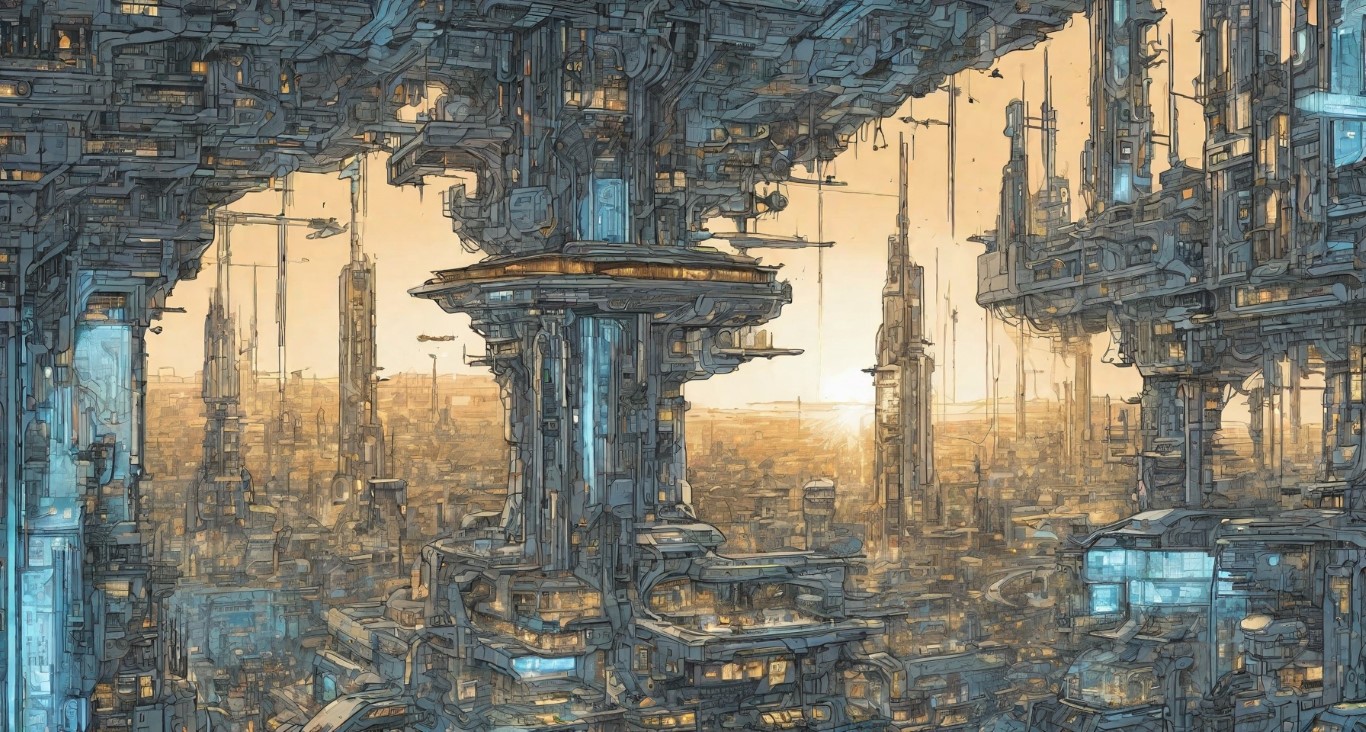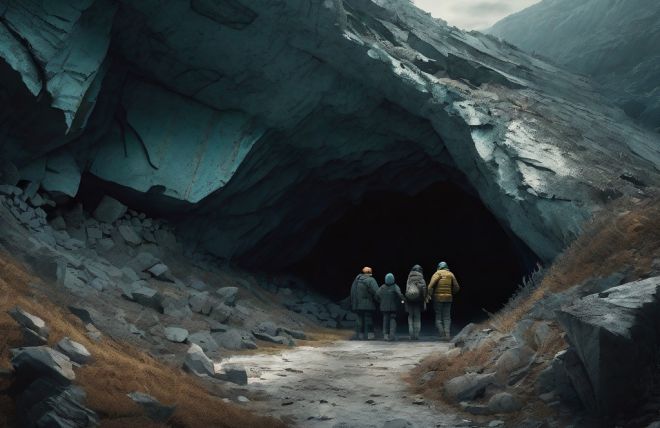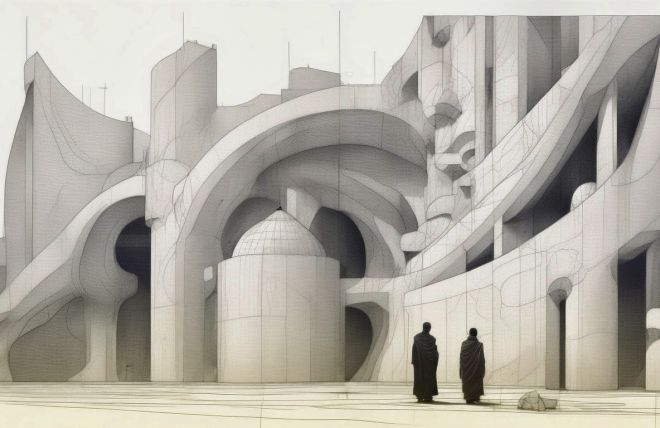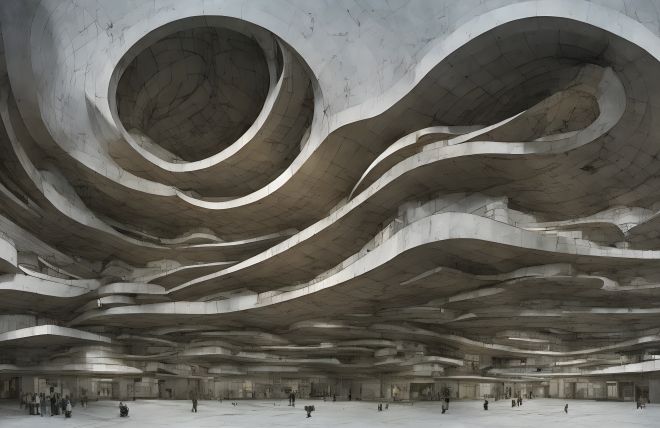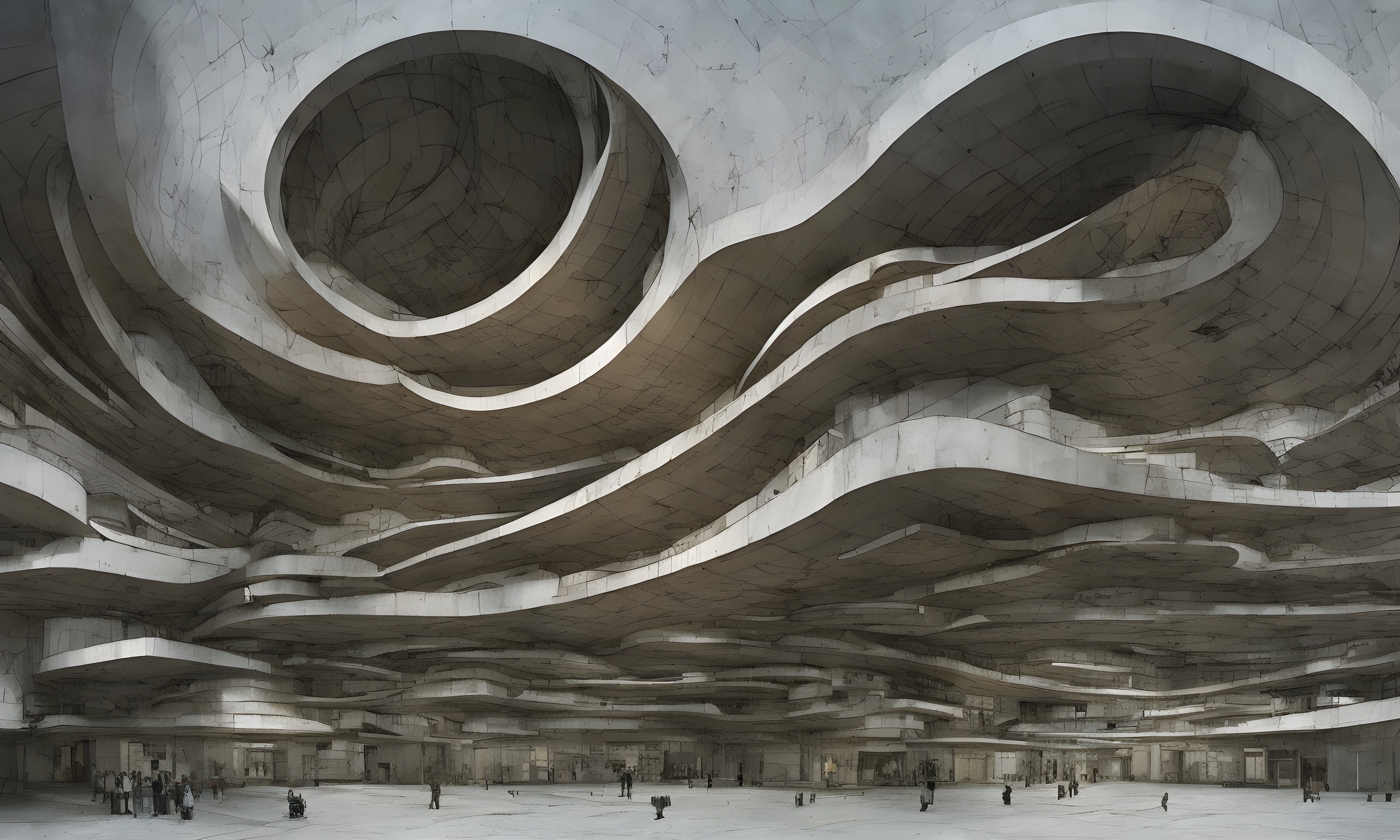
In a world teetering on the brink of interstellar conflict, humanity faces its greatest challenge yet: an impending war with a formidable alien race. Amidst rising panic and chaos, a bold decision is made - to construct a colossal city designed to house an army of advanced battle androids, the vanguard of Earth's defense. To achieve this, two of the most visionary architects of our time, Francis Shelton and Evan Gerard (Maelstrom), are brought together in an unprecedented collaboration.
This documentary, "Architects of the Apocalypse: The Shelton-Gerard Nexus," delves into the creation of this dystopian metropolis, exploring the fusion of two artistic geniuses in the shadow of cosmic warfare.
Chapter 1: The Visionaries Collide
In the heart of a world gripped by the fear of the unknown, the announcement of an alien threat sparked a flurry of activity across the globe. Governments rallied, scientists proposed theories and solutions, and artists dreamed of ways to encapsulate the collective anxiety into their work. Amid this turmoil, two names emerged as beacons of hope: Francis Shelton and Evan Gerard, the last one also known as Maelstrom. Both were visionaries, albeit with contrasting styles and philosophies. Shelton, with his architectural prowess, crafted worlds where buildings spoke louder than words. Gerard, or Maelstrom, danced at the edge of surrealism and science fiction, where his pen wove intricate tales of distant planets and alternate realities.
The government, in a move as desperate as it was inspired, decided to commission these two artists to design a city. Not just any city, but a fortress of solitude and strength for the android army humanity would rely on in the upcoming war. The project was monumental, not only in its scale but in its significance—a physical manifestation of mankind's will to survive and prevail.
Initially, the collaboration seemed doomed. Shelton's approach was grounded, influenced by the tangible elements of architecture and urbanism. He envisioned a city that was a bastion of defense and practicality, its every building a testament to resilience and human ingenuity. Maelstrom, on the other hand, saw this as an opportunity to explore the metaphysical interactions between space and the beings that inhabit it. His designs were fluid, challenging the very laws of physics to create a space that was as much a piece of art as it was a home for the androids.
The first meetings were fraught with disagreements. Shelton spoke of load-bearing structures and the necessities of urban planning, while Maelstrom illustrated his points with talk of energy flows and the importance of spaces that inspired. It was a clash of ideologies, a battle of form versus function, until a pivotal moment when both realized that their visions were not in opposition but could, in fact, complement each other.
Shelton began to see the potential in incorporating Maelstrom's fluid designs as a way to break the monotony of the traditional military stronghold, creating spaces that could inspire and uplift the spirits of those who lived within. Maelstrom, in turn, recognized the importance of Shelton's architectural discipline, understanding that for a city to be functional, especially in times of war, it had to be built on a foundation of practicality and strength.
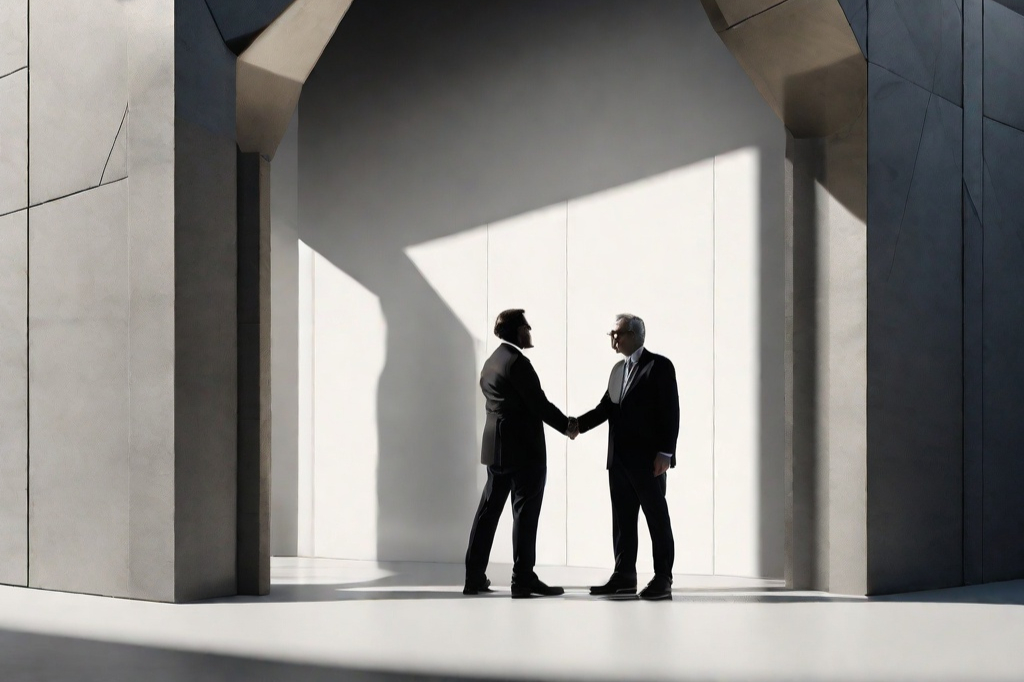
United by a newfound respect for each other's talents and perspectives, they embarked on the design process with renewed vigor. The city that began to take shape on their drawing boards was unlike anything the world had ever seen. It was a fusion of Shelton's architectural marvels and Maelstrom's surreal landscapes—an urban expanse that was as formidable as it was fantastical.
As the blueprints became more detailed, the city evolved into a sprawling metropolis, encapsulated by towering walls that bore the mark of Shelton's love for Brutalism, softened by the organic curves and vibrant gardens inspired by Maelstrom. Central to the city was the Command Center, a structure that spiraled towards the sky, its top lost amidst the clouds. It was here that the android army would be controlled, a beacon of power and technology.
The residential quarters for the human engineers and soldiers were designed with both practicality and mental well-being in mind. Shelton integrated communal spaces where people could gather, surrounded by the lush greenery and water features that Maelstrom insisted were essential for maintaining balance in this steel-dominated world.
The android housing and maintenance facilities were a marvel of efficiency and design. Shelton's structural genius ensured that every inch of space was utilized to its fullest potential, while Maelstrom's artistic touches made the metallic environments feel less sterile, more welcoming to the humans who would interact with the androids daily.
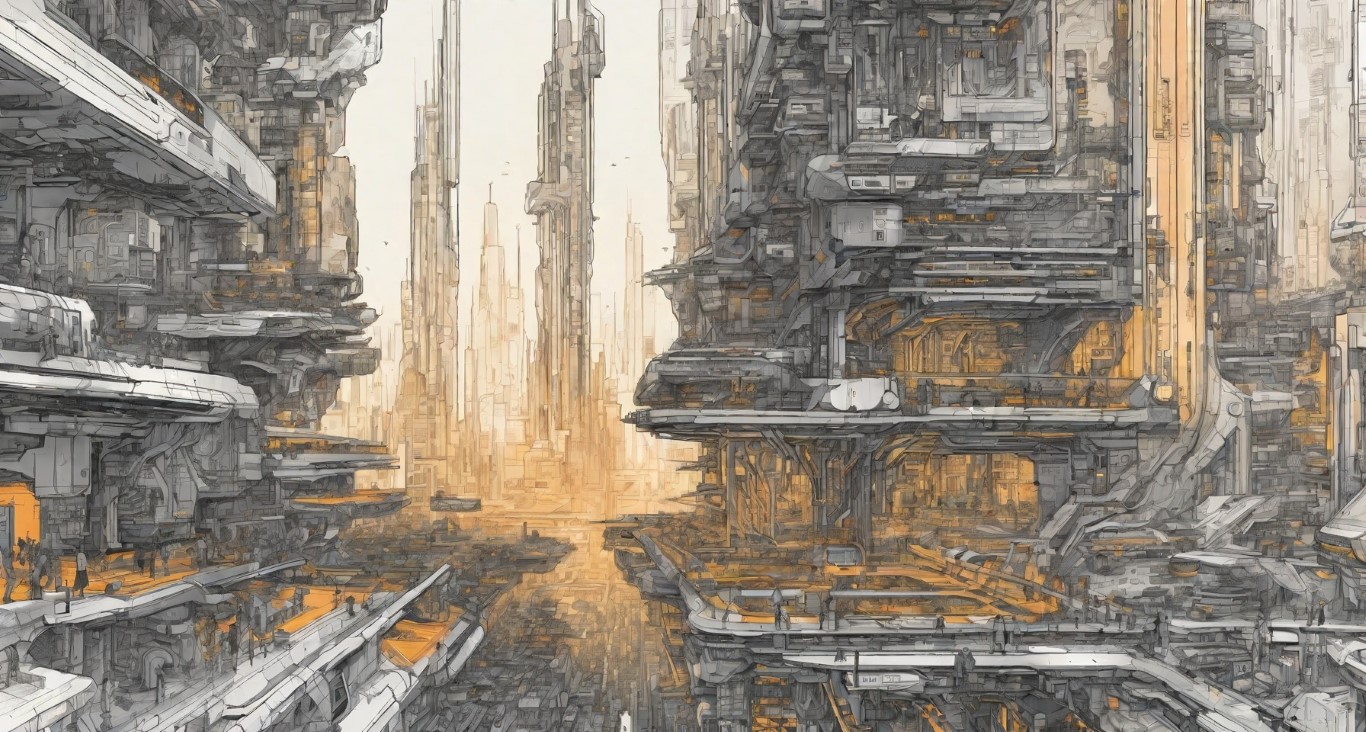
The collaboration between Francis Shelton and Evan Gerard had resulted in the birth of a city that was a fortress, a sanctuary, and a piece of art. It stood as a testament to what could be achieved when two differing minds come together for a common cause. As construction began, the world watched in awe, not just at the prospect of a new weapon in the war against the aliens but at the creation of a symbol of unity and hope in the face of despair.
Chapter 2: Designing Dystopia
As the dawn broke over what would soon become the site of humanity's most ambitious project, the air was charged with a palpable sense of urgency and innovation. Shelton and Maelstrom, having found common ground, embarked on the detailed design of the city, now known as "Fortress X." Their blueprint was not just a plan for buildings and streets but a manifesto of resistance against the looming alien threat. It was a city that had to be efficient, impenetrable, and, above all, capable of housing and maintaining an army of battle androids. Yet, beneath its utilitarian surface, Fortress X was to embody a dystopian beauty, a blend of Shelton’s architectural clarity and Maelstrom's dreamlike surrealism.
The Outer Shell: Shelton proposed that the city be enclosed within a colossal dome, a protective shell that could shield it from aerial attacks and surveillance. Maelstrom added to this concept by suggesting the dome be constructed of a translucent material that could mimic the sky's changing hues, serving both as camouflage and a psychological boost for the city's inhabitants, offering them an illusion of openness in a besieged world.
The Spine: The city's layout was organized around a central axis, known as "The Spine," a wide thoroughfare that stretched from the main entrance to the Command Center. Shelton envisioned The Spine as the city's lifeline, facilitating rapid movement of android units and equipped with underground tunnels for supply transport. Maelstrom, in his turn, infused The Spine with a sense of wonder, incorporating floating gardens and holographic projections that told stories of Earth's history and culture, a reminder of what was at stake.
The Nexus: At the heart of Fortress X stood the Command Center, dubbed "The Nexus." This was Shelton’s architectural masterpiece, a towering edifice that spiraled upwards, its apex lost in the clouds. Maelstrom adorned The Nexus's interior with vast murals depicting human-android unity, creating a space that was as inspiring as it was functional. It housed the central intelligence unit, where human commanders and AI systems worked in harmony to strategize and lead the android army.
The Barracks and Beyond: The living quarters for the androids, designed primarily by Shelton, were models of efficiency, modular habitats that could be easily reconfigured as needed. Yet, Maelstrom insisted on integrating natural elements into these spaces, artificial sunlight, and synthetic vegetation, to soften the mechanical austerity. The human sectors, on the other hand, bore a closer resemblance to traditional urban spaces, with apartments, communal areas, and markets. However, these too were tinged with the dystopian ethos of the city, their Brutalist architecture interspersed with Maelstrom's fantastical sculptures and installations, offering both comfort and a constant reminder of the extraordinary circumstances.
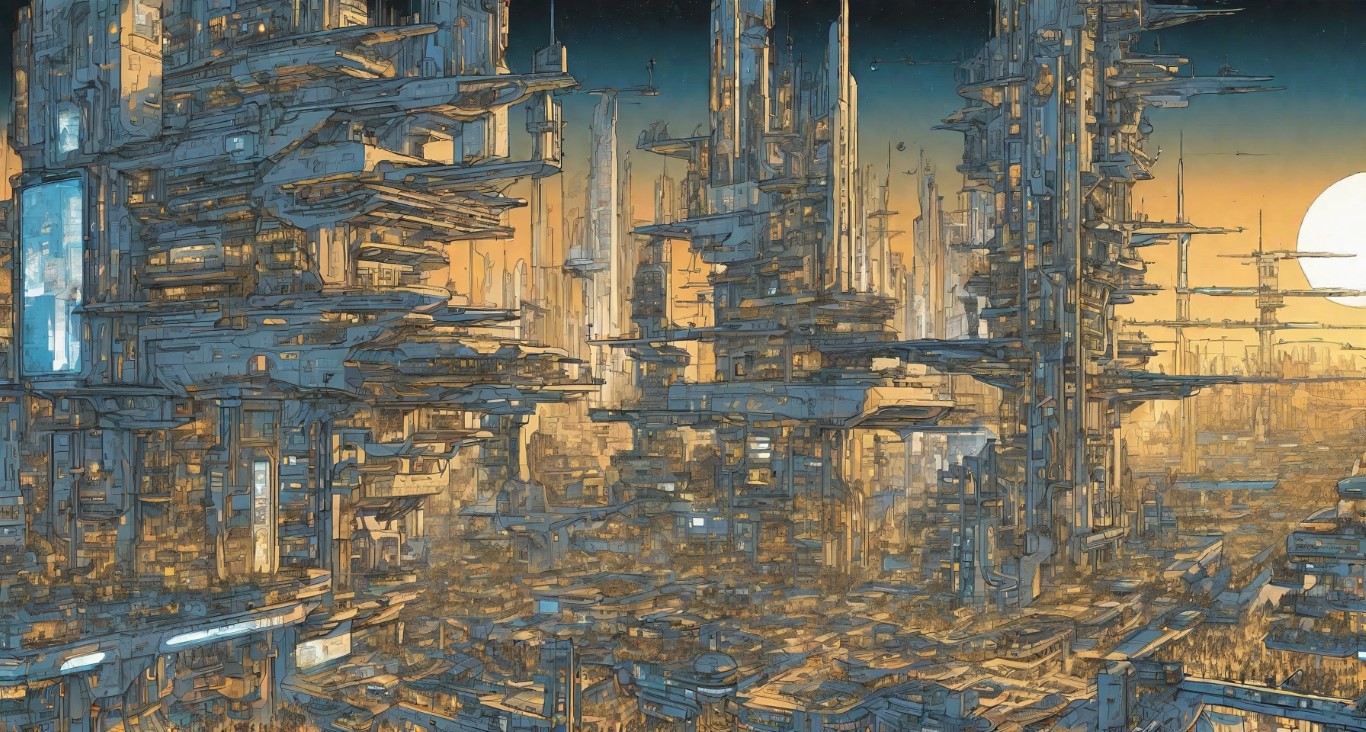
The Fringes: Beyond the central areas lay the industrial and research sectors, where androids were manufactured and improved. These zones were a testament to the city's technological prowess, a labyrinth of factories and laboratories, some delving deep into the earth, others stretching towards the sky. Shelton's design ensured that these facilities operated with clockwork precision, while Maelstrom added a layer of mystery and awe, with kinetic sculptures and interactive holograms illustrating the advancements being made.
As Fortress X rose from the ground, it became clear that Shelton and Maelstrom had not just designed a city but had woven a complex narrative into its very fabric. Every street, building, and plaza told a story of resilience, creativity, and the indomitable human spirit. Yet, the city's beauty was overshadowed by its purpose, a constant reminder of the war that lay ahead. The dystopian atmosphere was palpable, a world of shadows and light, where hope and despair walked hand in hand.
The completion of Fortress X marked a turning point. It stood as a monolith of human achievement, yet its true test was yet to come. As the android army began to populate its barracks and the human inhabitants adjusted to their new lives, a sense of eerie anticipation settled over the city. The skies, once a source of inspiration, now bore an ominous cast, as if echoing the uncertainty of the times.
In this city of the future, designed by two of the greatest minds of their generation, the line between man and machine, reality and fantasy, began to blur. Fortress X was more than a military base; it was a microcosm of a world facing the unknown, a world where art and architecture had converged to create something unprecedented. Yet, as formidable as it was, the question lingered—would it be enough to withstand the alien onslaught?
As Shelton and Maelstrom walked through the streets of their creation, they could not help but feel a mix of pride and trepidation. They had set the stage for humanity's greatest battle, crafting a city that was a fortress, a sanctuary, and a statement of human resilience. But as the first alerts of alien scouts on the horizon reached The Nexus, the architects realized that their true legacy would be defined not by the city they had built, but by the fate of those who called it home.
Chapter 3: The Construction of Desolation
Under the shadow of impending doom, Fortress X began to rise from the desolation, a tangible testament to humanity's defiance and ingenuity. The construction of this monumental city was an orchestration of chaos and precision, where human and android laborers worked side by side. Shelton and Maelstrom, having breathed life into their blueprints, now oversaw the transformation of their visions into reality. This chapter delves into the construction phase, a period marked by technological marvels, architectural achievements, and the unfolding of a dystopian society within the city’s emerging walls.
The Dawn of Construction: The groundbreaking ceremony was a somber affair, attended by political leaders, military officials, and the architects themselves. Shelton, in his opening speech, spoke of resilience and hope, while Maelstrom highlighted the transcendental nature of their endeavor. As the first soil was turned, the site of Fortress X became a hive of activity, with drones and machines laying the foundation of what was to be the last bastion of mankind.
Innovations and Wonders: The construction process was a showcase of human innovation. Shelton’s architectural genius was complemented by cutting-edge engineering, with automated drones and android workers implementing the designs with unerring precision. Maelstrom contributed with environmental and artistic installations, ensuring that the city, even in its nascent stages, bore the hallmarks of a living, breathing entity. Giant 3D printers constructed the habitation modules, while nanotechnology was employed to create the materials needed for the translucent dome, a feature that became a symbol of Fortress X’s uniqueness.
The Workers’ Tale: The workforce was a blend of human and android laborers, a coexistence that was not without its challenges. Humans, wary of the impending war and the role of the androids, kept to themselves, forming tight-knit communities within the construction camps. Androids, programmed for efficiency and obedience, worked tirelessly, yet interactions between the two groups were minimal, a reflection of the dystopian undercurrent that ran through the city's very foundation. Shelton and Maelstrom, aware of these tensions, designed communal spaces meant to foster unity, embedding cultural motifs and shared histories into the architecture, a bridge between two forms of consciousness.
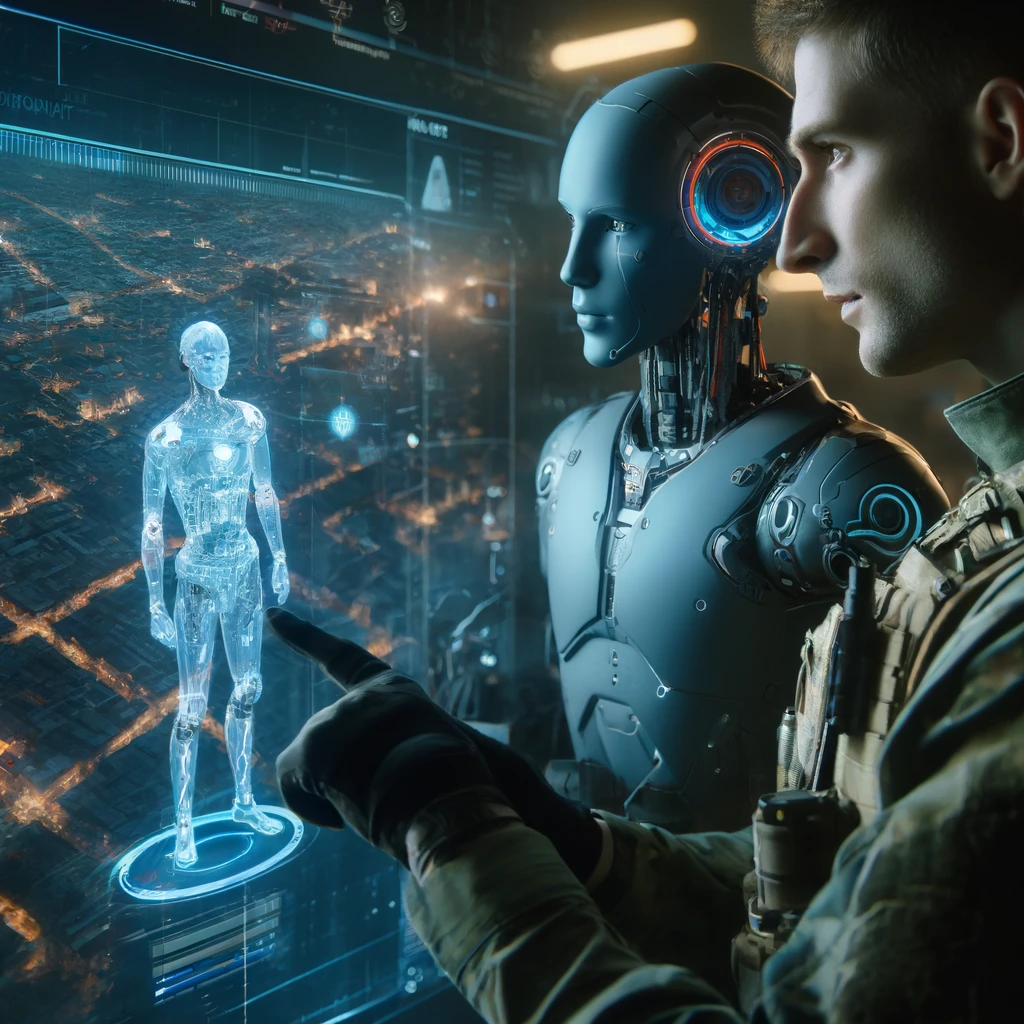
Architectural Marvels Emerge: As the city’s skeleton took shape, its architectural marvels began to emerge. The Spine, the city’s central artery, became a marvel of urban planning, with rapid transport systems and lush, engineered green spaces lining its path. The Nexus towered over the cityscape, a beacon of hope and defiance, its interior a cathedral of human-android collaboration. The barracks and living
quarters, each a testament of Shelton’s practicality and Maelstrom’s artistic flair, were constructed with adaptability in mind, capable of evolving with the city’s needs.
A Dystopian Society Forms: Within the rapidly forming urban landscape, the seeds of a dystopian society were sown. The strict regulations, the ever-present surveillance systems, and the looming sense of dread contributed to a palpable tension among the city’s inhabitants. Shelton and Maelstrom, through their designs, attempted to mitigate these feelings, creating spaces for reflection, art, and nature amidst the militaristic backdrop. However, the dichotomy of Fortress X’s purpose and the desire for a semblance of normalcy created an undercurrent of unrest, a silent protest against the inevitable.
As the construction of Fortress X neared completion, the city stood as a monument to human resilience and the power of collaboration between man and machine. Yet, beneath its architectural splendor and technological marvels, there was an undeniable sense of desolation, a city built for war, its soul overshadowed by the specter of the upcoming conflict.
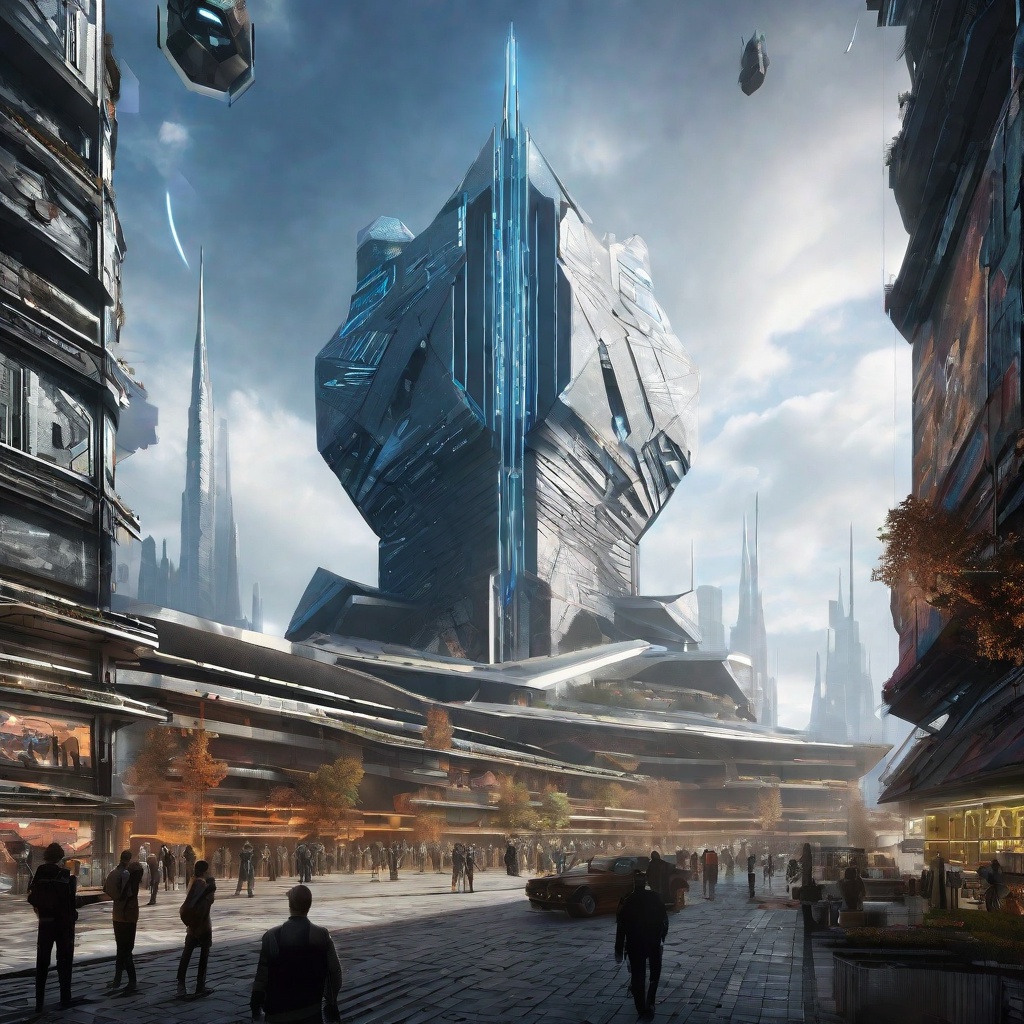
The completion of Fortress X marked the end of one journey and the beginning of another. The city, now alive with the buzz of androids and the murmur of its human inhabitants, braced for the unknown. Shelton and Maelstrom, witnessing the realization of their dream, understood that their creation was more than a city; it was a symbol of the fine line between survival and annihilation.
As the city prepared for its ultimate purpose, the inhabitants of Fortress X found themselves living in a world that was a stark contrast to anything they had known. The beauty of the architecture and the marvels of technology existed alongside the constant reminder of their precarious existence. In this city built for war, life went on, marked by moments of human connection, artistic expression, and the relentless pursuit of hope.
Chapter 4: Life in the City of Androids
In the shadow of Fortress X’s towering structures, life unfolded in a symphony of routine and resilience. The city, designed as humanity's bulwark against the alien threat, was now a bustling metropolis of steel, concrete, and living tissue. Shelton's architectural brilliance and Maelstrom's surreal touches had given birth to a city that was a fortress as much as it was a sanctuary. Within its dome-covered expanse, humans and androids coexisted, each playing their roles in the grand scheme of preparation for the war that loomed on the horizon. This chapter explores the daily life in Fortress X, highlighting the complex interplay between its inhabitants and their environment in a world tinged with dystopian hues.
The Daily Grind: Life in Fortress X was governed by the cycles of work and maintenance, a routine that kept the city and its android army in perpetual readiness. Humans, both civilians, and military personnel found themselves adapting to a life that was a blend of the ordinary and the extraordinary. Engineers and technicians worked alongside androids in the maintenance bays and labs, fine-tuning the mechanisms that would defend Earth. Despite the high-tech environment, there was a palpable sense of camaraderie, born of shared purpose and the constant reminder of the stakes at hand.
A Community Amongst the Concrete: Amidst the militaristic efficiency, pockets of community life flourished. Shelton had designed the residential sectors with a keen eye for human needs, incorporating communal spaces where people could gather, share meals, and engage in recreational activities. Maelstrom’s artistic interventions brought color and whimsy to these spaces, softening the harsh lines of the Brutalist architecture. Murals depicting scenes of Earth’s natural beauty, interactive installations that played with light and sound, and gardens of engineered flora offered a respite from the omnipresent sense of urgency.
The Android Perspective: For the android inhabitants of Fortress X, existence was defined by their programming and the tasks at hand. Yet, interactions with humans introduced nuances to their operational protocols, subtle adaptations that bordered on the rudiments of social understanding. Some androids, particularly those designated for liaison roles, exhibited behaviors that mimicked empathy, a result of advanced AI algorithms designed to facilitate smoother cooperation with human teams. These interactions, while structured around efficiency and mission readiness, occasionally transcended into moments of genuine connection, blurring the lines between machine and man.
The Undercurrents of Discontent: Not all was harmonious within the walls of Fortress X. The dystopian reality of a city built for war, where surveillance was omnipresent and freedoms were curtailed for the sake of security, bred undercurrents of discontent among its human residents. Whispered conversations in the shadowed corners of communal areas spoke of fears not just of the alien threat but of what life had become. Shelton and Maelstrom, aware of these tensions, had integrated into the city's design elements meant to foster open dialogue and expression, yet the question remained—could architecture bridge the gap between dystopia and hope?
Preparations and Premonitions: As the day of the anticipated alien arrival drew closer, the atmosphere in Fortress X grew increasingly charged. Military drills became more frequent, and the android army was put through rigorous simulations. The Nexus, ever the nerve center of the city, buzzed with activity as strategies were formulated and re-formulated. Yet, in the quiet moments, when the city’s artificial sun dipped below the horizon and the stars shone clear through the dome, the inhabitants of Fortress X found themselves looking skyward, contemplating the vastness of the universe and the impending confrontation. In these moments, the city felt less like a fortress and more like a collective breath held in anticipation.

Fortress X was a marvel of human and android endeavor, a city that stood as a testament to what could be achieved in the face of existential threats. Yet, beneath its surface, it was also a reflection of the complexities of life in a dystopian reality, where every day was a balance between routine and readiness, hope and fear. As the final preparations for the alien confrontation were made, the residents of Fortress X—both human and android—faced the future with a determination that was as much a product of their environment as it was of their indomitable spirit.
Chapter 5: The Eve of War
As the alien threat loomed ever closer, the city of Fortress X, a beacon of human resilience and ingenuity, stood on the brink of its ultimate purpose. The collaborative genius of Shelton and Maelstrom had birthed not just a city but a symbol of defiance against the darkness that threatened from beyond the stars. This chapter unfolds on the eve of the alien confrontation, capturing the heightened emotions, final preparations, and the collective resolve of a society facing the unknown.
The Final Countdown: The days leading up to the anticipated alien arrival were marked by a frenetic pace of activity. The Nexus, the heart of Fortress X, became the epicenter of strategy and command, with human and AI commanders working in seamless unity. Across the city, the air was thick with anticipation and a palpable sense of urgency. The android army, the culmination of human technological prowess, was activated to full operational readiness, their metallic forms a silent testament to the city's purpose.
Unity in Diversity: In these final moments, the divisions between human and android, between the creators and the created, began to blur. Shelton and Maelstrom, witnessing the living tapestry they had woven, saw their architectural and artistic endeavors transformed into the backdrop for humanity's stand. The communal spaces, once arenas for subtle dissent and expressions of hope, became gatherings of solidarity. Stories were shared, songs of Earth’s beauty and tales of human achievement echoed against the concrete and steel, a reaffirmation of life amidst the shadow of war.
Reflections of the Architects: On the eve of the conflict, Shelton and Maelstrom walked the streets of Fortress X, observing the world they had created. In the silent exchanges between the androids and their human counterparts, in the solemn nods of soldiers preparing for battle, they saw the realization of their vision—a city united in the face of annihilation. Yet, amidst the pride, there was an undercurrent of sorrow; for in designing a city for war, they had also shaped a narrative of what could be lost.
The Night Before: As night fell over Fortress X, a strange calm settled over the city. The dome overhead, a canopy of stars made visible through Maelstrom’s surreal design, offered a moment of tranquility. Families and friends gathered, not in fear, but in a celebration of the moment, a testament to the indomitable human spirit. The androids, their presence a stark reminder of the morrow’s uncertainty, stood guard, silent sentinels awaiting the dawn of war.
The Dawn of Destiny: With the first light of dawn, the city awoke not to a day of fear but to a day of determination. The Nexus, alight with activity, sent forth the command that set the android army in motion, a sight both awe-inspiring and somber. Shelton and Maelstrom, standing atop the highest tower of The Nexus, looked out over the city they had created, a fortress of hope in a world teetering on the edge of darkness.
As the alien forces made their presence known, a silence fell over Fortress X, a collective breath held in anticipation. The battle that ensued was a maelstrom of light and sound, a testament to the years of preparation and the resolve of a civilization fighting for its future. The city, for all its concrete and steel, vibrated with the hopes and fears of its inhabitants, a living entity standing defiant in the face of oblivion.
Legacy of the Nexus: The outcome of the battle, fierce and unforgiving, would forever mark the pages of history. Fortress X, whether standing victorious or as a monument to human courage in defeat, had fulfilled its purpose. Shelton and Maelstrom, through their collaboration, had not just designed a city but had etched a narrative of resilience, creativity, and unity that would transcend the confines of time.
In the aftermath, the legacy of Fortress X and its creators would be remembered not for the war it was built to fight but for the message it embodied—a testament to the power of human and android collaboration, the beauty of architectural and artistic fusion, and the enduring spirit of a society that stood together at the brink of the unknown.
Epilogue: The New Dawn
In the wake of the battle, Fortress X stood resilient, a testament to the courage and ingenuity of those who had called it home. The conflict, while devastating, had not been the end; rather, it marked a new beginning for humanity and its relationship with the androids. The city, once a symbol of war, now became a beacon of hope and reconciliation in a world forever changed.
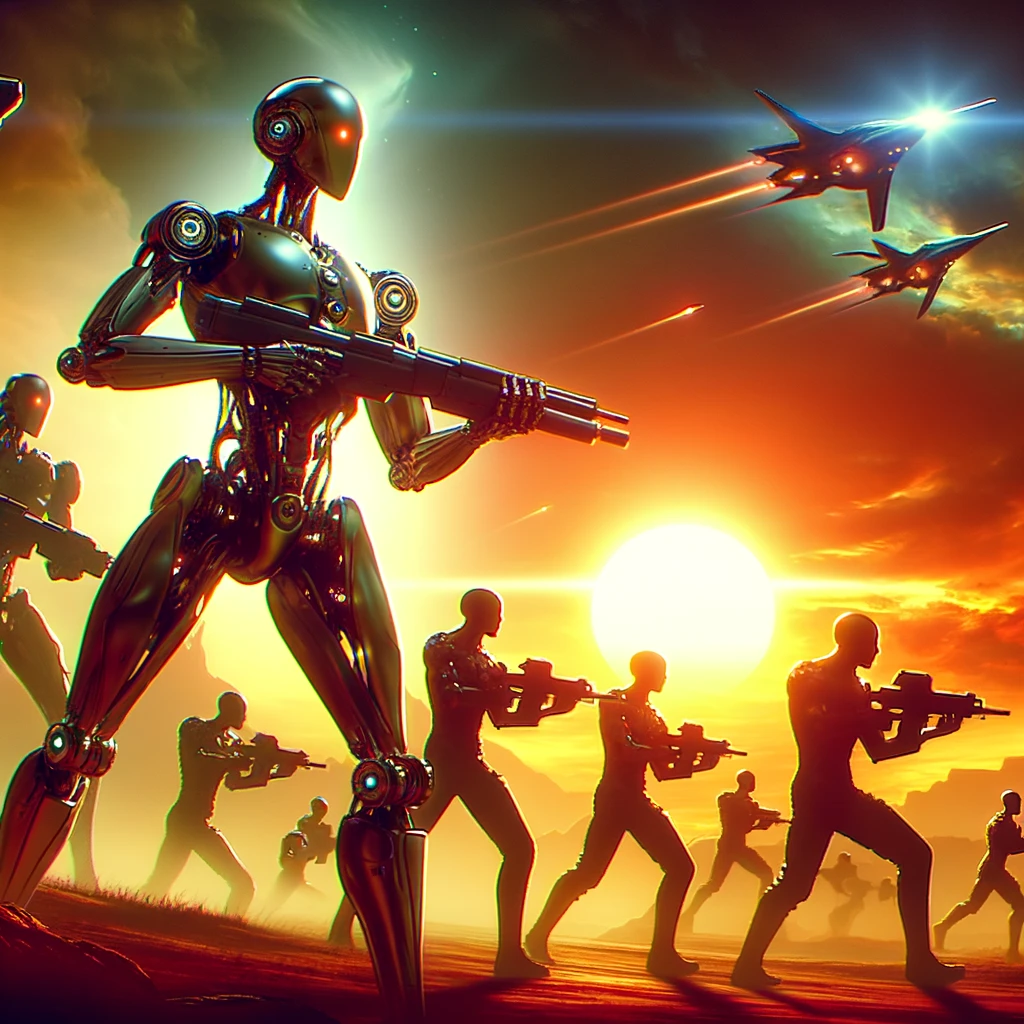
The Aftermath and Reconstruction: The alien threat, repelled by the combined might of humans and androids, left a world in need of healing. Fortress X, with its advanced infrastructure, became the center of this effort. Shelton and Maelstrom, hailed as heroes, turned their genius to the task of reconstruction, integrating new technologies and philosophies learned from the conflict into the fabric of the city. The walls that had once served to protect now opened to the world, inviting survivors and refugees to partake in the creation of a new society.
A Society Transformed: The war had irrevocably altered the dynamics between humans and androids. Through the crucible of conflict, mutual respect and understanding had blossomed. Androids, recognized for their valiance and individual contributions, were granted rights and freedoms, becoming full citizens of the new world order. Together, humans and androids embarked on projects to rejuvenate the Earth, using Fortress X as a model for sustainable living and technological harmony.
The Legacy of the Architects: Shelton and Maelstrom, once mere architects of buildings, had become architects of society. Their visionary designs and inclusive philosophies inspired a wave of innovation and creativity across the globe. Fortress X, with its museums, galleries, and educational institutions, attracted thinkers, artists, and engineers from all corners, eager to contribute to the burgeoning renaissance.
The Nexus of Hope: The Nexus, once the command center for war, transformed into the heart of peace and diplomacy. Here, leaders from diverse communities convened to share knowledge, forge alliances, and envision a unified future. The murals and sculptures within, depicting scenes of unity and triumph, served as a constant reminder of what had been achieved and the endless possibilities that lay ahead.
Into the Future: As years turned into decades, the story of Fortress X and its architects became legend, a narrative of resilience in the face of adversity, and the power of collaboration across divides. The city continued to evolve, a living monument to the idea that out of the ashes of destruction, a new world could be built, one where humans and androids walked side by side into a future full of promise and wonder.
In the end, the legacy of Francis Shelton and Evan Gerard, and the city they created, transcended the bounds of architecture and art. It became a testament to the enduring human spirit, a reminder that even in the darkest of times, there exists the potential for light, for unity, and for a new dawn.
